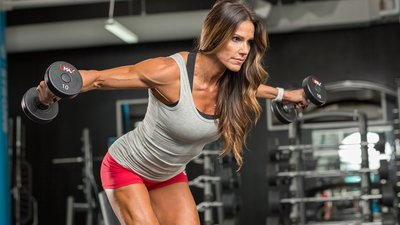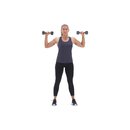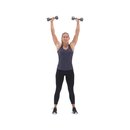Two years. That's how long it took Stephanie EchoHawk to get her shoulders where she wanted them to be. "And I continue to lift at least two times a week to maintain them," she adds. "Developing well-rounded shoulders gives the appearance of a smaller waist. And since they're involved in just about every upper-body move, strong shoulders should be a high priority for women who lift regularly."
Here's how and when she trains her shoulders, plus her favorite tips for every movement.
The Plan to Build 360 Delts
Because shoulders move in so many planes of motion, as well as in rotation, they need a proper warm-up before training. EchoHawk likes to start with two sets each of light dumbbell overhead presses, lateral raises, and internal and external rotator cuff moves, to get all her muscles firing and blood moving into her shoulders.
She then begins her workout, consciously hitting all three delt heads by starting in the front and working her way around to the back. "I rest only long enough between sets to stretch, which helps keep me moving and my muscles firing," she says.
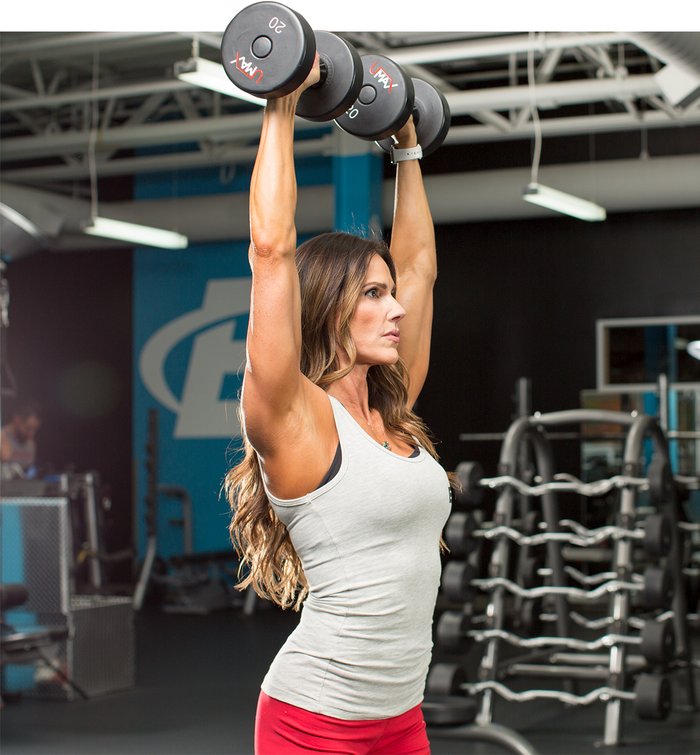
In terms of reps and weight, she believes in variety. "I lift heavier and with fewer reps on some exercises, like overhead presses. But with moves like cable lateral raises, I might lift lighter weight for higher reps," she says. "I also alternate between the two, depending on where I am in my competitive season. When I eat more carbs, I can lift heavier. When I eat fewer carbs, I use less weight and perform higher reps."
EchoHawk also likes to use advanced techniques when trying to grow her shoulders. "I use dropsets quite a bit, to get in a few more reps once I reach failure with a weight. In any given set, you're recruiting only a certain amount of muscle fibers. By dropping the weight and going lighter, you recruit different fibers, which can help the muscles grow."
Weekly Workout Split
- Monday: Shoulders, abs, HIIT training 15-20 min.
- Tuesday: Posterior chain of the legs, steady-state cardio 10 min.
- Wednesday: Back, biceps, abs
- Thursday: Chest, triceps, HIIT training 15-20 min.
- Friday: Anterior chain of the legs, steady-state cardio 10 min.
- Saturday: Shoulders, Abs, HIIT training 15-20 min.
- Sunday: Yoga, walking

BodyFit
$6.99/month- 2,500+ expert-created single workouts
- 3,500+ how-to exercise videos
- Detailed workout instruction
- Step-by-step workout tips
- Training at gym or at home
- Access to Workout Plans
- Access to Bodyfit App
- Store Discounts
Already have a Bodybuilding.com account with BodyFit? Sign In

What comes with BodyFit?

- Instructional Videos
Don't risk doing a workout improperly! Avoid injury and keep your form in check with in-depth instructional videos.

- How-to Images
View our enormous library of workout photos and see exactly how each exercise should be done before you give it a shot.

- Step-by-Step Instructions
Quickly read through our step-by-step directions to ensure you're doing each workout correctly the first time, every time.
Technique Keys
Standing overhead dumbbell press
Nothing beats overhead presses for muscle building, since they hit all three heads of the delts, as well as the traps and upper back. Do them standing, and you increase the intensity. "The standing shoulder press requires more stability, actively strengthening your core while working your shoulders," says EchoHawk.
EchoHawk likes to increase her weight with each set, adding enough to make it more challenging, but not so much that she can't complete at least 12 reps.
Single-arm landmine shoulder press
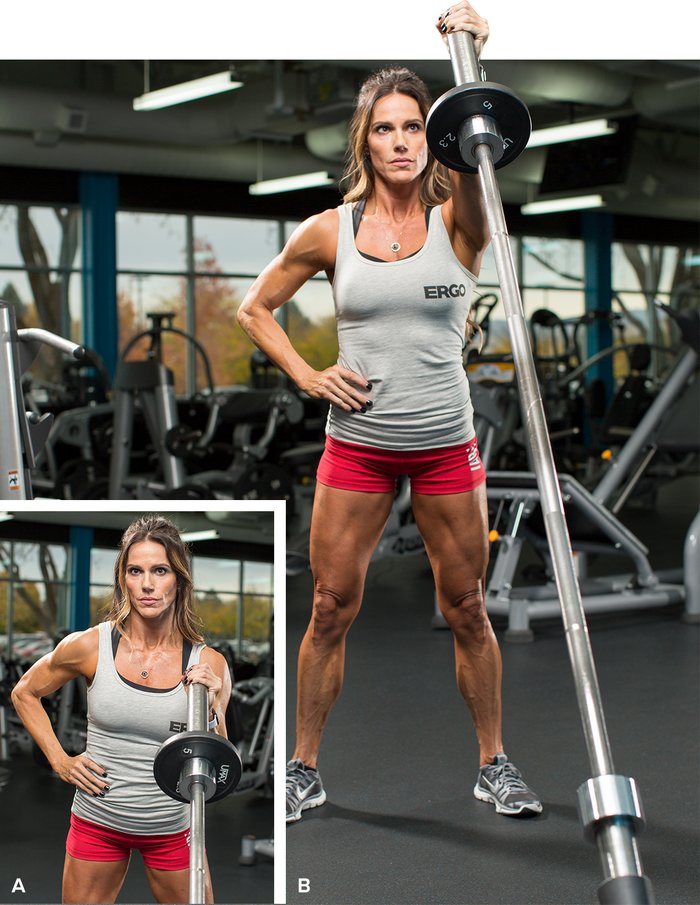
Single-Arm Landmine Shoulder Press
Another solid mass builder, the single-arm press done with a landmine targets the anterior delts, while engaging the core and hips to help promote upward drive. This is increasingly popular among athletes, since it demands coordination and balance as well as strength. "For these, I rest 45 seconds between each set and each side," says EchoHawk. "I also do straight sets here. I don't pyramid my weight."
Single-arm dumbbell lateral raise with lean
Isolation moves are key when trying to grow a specific area of the shoulder, and EchoHawk's target is her lateral delts. Doing this classic move with a slight lean was a game-changer for her.
"Leaning helps increase the lateral deltoid's time under tension, which can lead to greater muscle growth," she says. "If you want more intensity, do a dropset or use higher reps, and really focus on using no momentum at all. You may have to use a lighter weight, though, because you'll fatigue more quickly."
EchoHawk uses straight sets with the same weight for all four sets here, but chooses a dumbbell that brings her close to failure by the 12th rep. "I only rest 30 seconds between each set and move from arm to arm with no rest."
Cable upright row
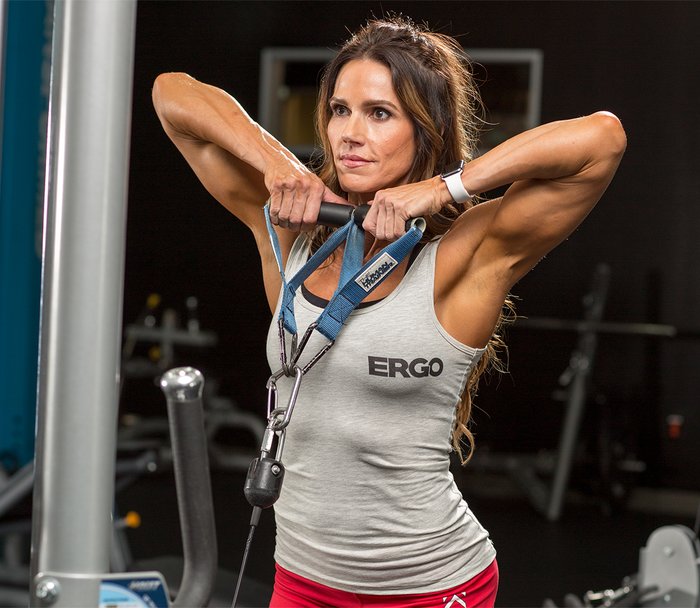
Cable Upright Row
Upright rows are great for developing the lateral delts and traps, and cables offer continual tension from start to finish with each rep.
"I like to use two handles rather than a straight bar for my upright rows, because I can get my hands into a better position," says EchoHawk. "Handles allow me to really drive up with my elbows, make sure I have a straight line through my wrists, and put all the tension on my medial deltoid."
Here, EchoHawk again edges toward failure within 12-15 reps and keeps things moving with 30-second rest intervals.
Standing bent-over lateral raise
The rear delts are often the missing link in shoulder development. "It's definitely the shoulder muscle most overlooked by women," says EchoHawk. "Most exercises cause you to protract your shoulders and collapse your posture forward, which can give you a forward head tilt and a weak core. Strengthening your rear delts helps pull your shoulders back and correct all those faults."
The bent-over lateral raise is one of two moves EchoHawk does on a regular basis to ensure rear delt development, and here she does straight sets using the same weight. "Remember, don't use momentum," she adds. "If you have to do that, you're using too much weight."
Single-arm reverse pec deck
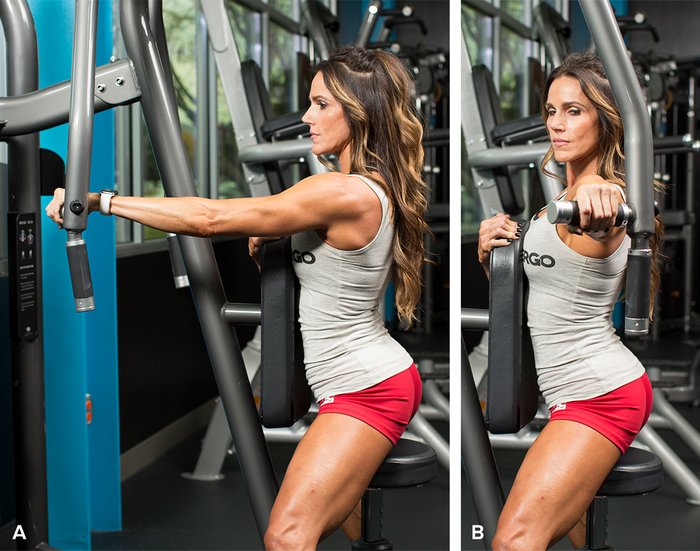
Single-Arm Reverse Pec Deck
The second move EchoHawk likes to use for rear delts is a pec-deck machine, but in a rather unusual way: unilaterally.
"By using only one arm at a time, I can really isolate each muscle and focus on the mind-muscle connection. Rear delts are a weak spot for me, so this is a good move to help me bring them up," EchoHawk says. She sometimes swaps this move for single-arm cable reverse flyes. Either way, she performs 12 reps per arm and builds in weight with each set.


